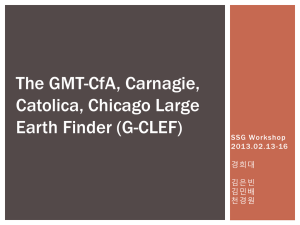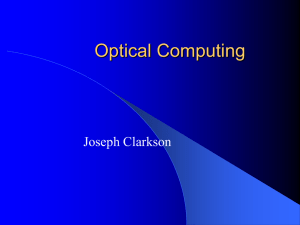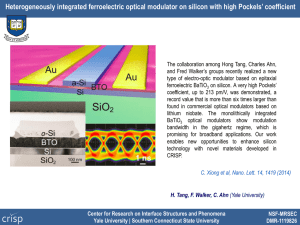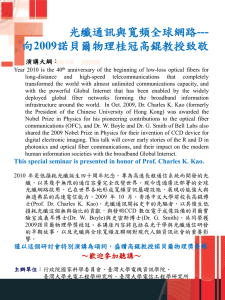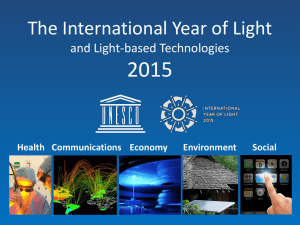Optical Wireless Communications
advertisement
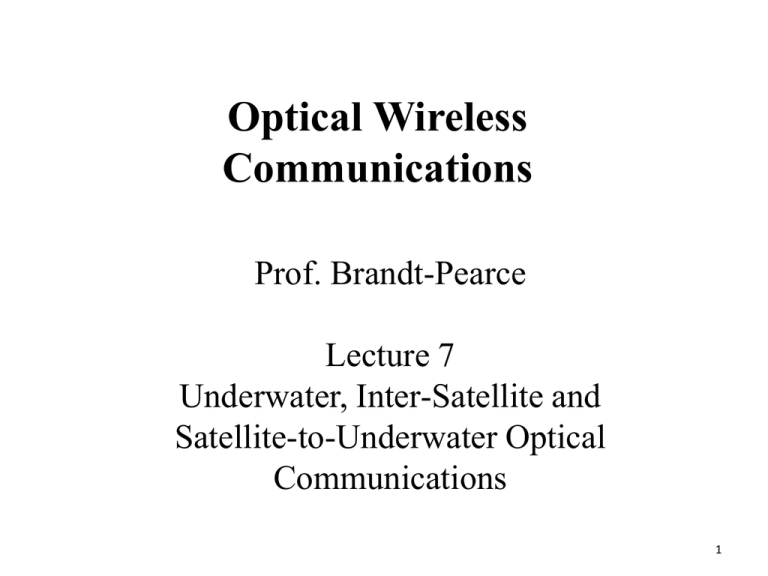
Optical Wireless Communications Prof. Brandt-Pearce Lecture 7 Underwater, Inter-Satellite and Satellite-to-Underwater Optical Communications 1 Outline Underwater Optical Communications Introduction Underwater Channel Challenges Inter-Satellite Optical Communications Satellite-to-Underwater Optical Communications 2 Underwater (UW) Optical Communications Modeling the channel is the first step in UW communications The channel is completely different from other FSO systems The transmitter and receiver can be very similar to aforementioned FSO systems Ocean water has widely varying optical properties depending on location, time of day, organic and inorganic content, as well as temporal variations such as turbulence and surface motion. To construct an optical link it is important to understand these properties. 3 UW Channel The physical properties of water is important in modeling the channel Ocean water vary both geographically and vertically with depth Geographically it changes from the deep blue ocean to littoral waters near land Vertically, the amount of light that is received from the sun is used to classify the type of water. The water depth also determines the background radiation from sun light 4 UW Channel The topmost layer is called the euphotic zone and is defined by how deeply photosynthetic life can be found Below this zone is the disphotic zone (1 km deep): the light is too faint to support photosynthesis. From the lower boundary of this zone and extending all the way to the bottom is the aphotic zone, where no light ever passes and animals have evolved to take advantage of other sources of food. 5 UW Channel The various water types are divided into two categories: oceanic (blue water) and coastal waters (littoral zone). The oceanic group is subdivided into 3 groups: Type I-III types I: extremely pure ocean water type II: turbid tropical-subtropical water type III: mid-latitude water The coastal group are subdivided into Types 1 through 9 1-9: coastal waters of increasing turbidity 6 UW Channel Absorption, elastic and inelastic scattering: Absorption: aw = absorption of pure water aoc = specific absorption of chlorophyll ay = specific of yellow substance (acids) 7 UW Channel The spectral transmittance for various water types 8 Absorption in UW Channel Pure seawater is absorptive except around a 400nm-500nm window, the blue-green region of the visible light spectrum Blue Green 9 Absorption in Natural Water “Absorption and scattering of light in natural waters” Vladimir I. Haltrin 10 Scattering in UW Channel Scattering in pure seawater is larger for shorter wavelengths 11 UW Link Geometries UW can be implemented in three different forms Line-of sight (LOS) Reflective Non-line-of-sight (NLOS) LOS: the transmitter directs the light beam in the direction of the receiver Reflective: Receiver receives the signal after reflection from sea surface NLOS: The power is received via scattering from particles inside water 12 UW Link Geometries: LOS The optical signal reaching the receiver is obtained by multiplying the transmitter power, telescope gain, and losses and is given by 𝑃𝑇 : average transmitter optical power 𝜂 𝑇 : optical efficiency of the transmitter 𝜂𝑅 :optical efficiency of the receiver d: perpendicular distance between the transmitter and the receiver 𝜃:angle between the perpendicular to the receiver plane and the transmitterreceiver trajectory 𝐴𝑅𝑒𝑐 : receiver aperture area 𝜃0 : laser beam divergence angle 13 UW Link Geometries: Reflective The UW reflective optical communications uses total internal reflection to transmit signal to the receiver In some communication scenarios the line of sight is not available In this case, the laser transmitter emits a cone of light, defined by inner and outer angles 𝜃𝑚𝑖𝑛 and 𝜃𝑚𝑎𝑥 in the upward direction 𝜃𝑖 : angles of incidence 𝜃𝑡 : angles of transmission Since the refractive index of air is lower than that of water, total internal reflection can be achieved above a critical incidence angle 𝑛𝑎𝑖𝑟 𝜃𝑐 = arcsin 𝑛𝑤𝑎𝑡𝑒𝑟 14 UW Link Geometries: NLOS For reflective communications the receiver and transmitter need to be close to sea surface It also requires some angle constraints; the transmitter and receiver distance have to be large compared to their depth Hence in some situations nor LOS nor reflective communications can be used Non-line-of-sight (NLOS) communications is the option that would be interesting for these cases. It is very similar to UV NLOS communications except the wavelength The transmitted optical signal is scattered in different directions because of molecules, particles and air bubbles 15 Challenges of UW Communications Inter-symbol interference (ISI) The power scattered inside water cause dispersion on the transmitted signal Not only the first order scattering is large, higher order scatterings are also have considerable effect on the received signal The broadened pulses cause ISI ISI effect can be severe since the scattering is strong for UW Background Light Since the operation wavelength is in visible range, the background radiation is strong for links that are close to surface Scintillation and Beam Wander Because of strong turbulences, the scintillation and beam wander effect is large The channel is not reliable unless a wide transmittance angle is used 16 Impulse Response of UW Communications Low scattering High scattering Medium scattering J. Li, et. al., “Channel capacity study of underwater wireless optical communications links based on Monte Carlo simulation” , Journal of Optics, J. Opt. 14 (2012) 015403 (7pp) 17 UW Communications Modulation Techniques Modulation techniques with high-spectral efficiencies are desired Spectral encoding modulations can only be done in blue to green range Non-coherent or differentially phase encoded modulations are preferred: OOK, PPM, DPSK Applications Submarine communications Underwater sensor networks 18 Outline Underwater Optical Communications Introduction Underwater Channel Challenges Inter-Satellite Optical Communications Satellite-to-Underwater Optical Communications 19 Inter-Satellite Optical Communications Optical communication is needed for connecting satellites to each other since it can provide Tb/s links Weight of the optical system that can be mounted on satellite is limited Lasers are used as sources because higher directivity of the optical beam allows higher data/power efficiency (more Mbps for each Watt of power) It requires highly accurate pointing acquisition and tracking 20 Applications Data relay (like the Tracking and Data Relay Satellites, TDRS, that served the Space Shuttle) (Mbps from a LEO/GEO satellite or aircraft to earth via another GEO satellite) For broadband links (multi-Gigabit over thousands of km) (in Telecom Constellations among S/C in LEO/MEO/GEO) For Space Science Links (Mbps or Kbps over millions of km) (between Lagrange Points of Interplanetary Space to Earth Stations or GEO) 21 Technologies First Generation of terminals were in 800-850 nm band- ASK(PPM)-Direct Detection Second Generation were in 1064 nm BPSK, Coherent Detection 1550nm, ASK, Direct Detection has been studied and demonstrated on ground 22 Challenges and Advantages Challenges: Galactic cosmic rays Solar wind high energy particles Magnetically trapped charged particles dependant on solar activity Thermal variations Advantages No turbulence No multipath effect No fading 23 Pointing and Tracking Pointing and tracking is the most important consideration Due to the relative motion of the stations, an active mechanism is required to maintain optical alignment Cooperative optical beam tracking is a viable solution in which each station employs the optical beam of the other station as a guide to point its own beam toward the other 24 Cooperative Optical Beam Tracking Transceiver structure The stations continually measure the arrival direction of their impinging optical beams using a position-sensitive photodetector In short range applications with negligible light propagation delay, the station transmit their optical beam along this measured direction For a large propagation delay, the optical beams must be transmitted within a certain angle with respect to the instantaneous 25 LOS Satellite-to-Underwater Optical Communications Communication from satellite to submarine has always been a problem This is because water is a good absorber of electromagnetic waves Exceptions are VLF and blue-green optical waves With VLF the depth of penetration is few tens of meters 26

